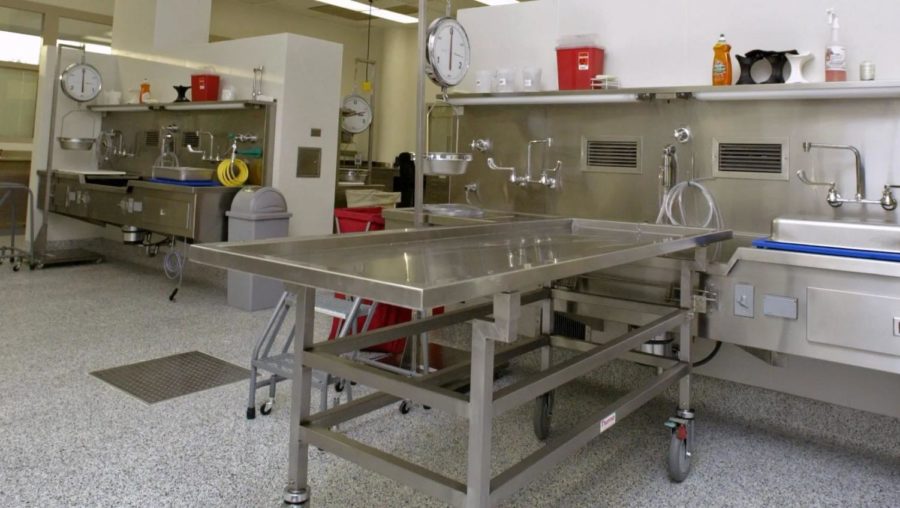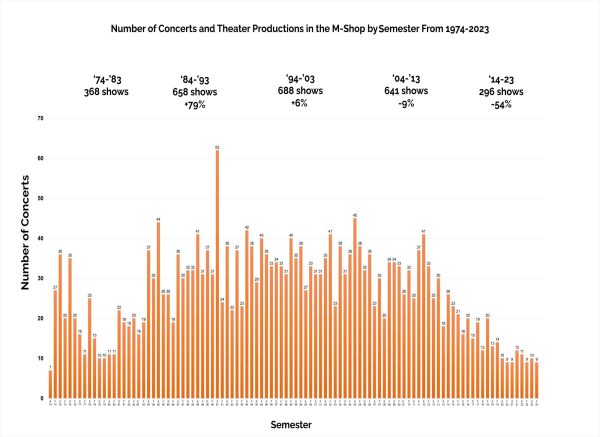Experts only: Where you go when you die
May 3, 2022
Three autopsies in under three hours: the average Saturday workload for a forensic pathologist at the Iowa Office of State Medical Examiners.
This is where Iowans go who die under unnatural or suspicious circumstances or if they are victims of a crime or accident. Forensic pathologists analyze the patient’s medical history and details of the death to determine the cause and manner of death.
The internal exam always begins with the abdominal cavities, but the order of organ removal depends on the doctor and the case. Starting with two incisions stretching from the body’s shoulders and in the center of the chest to form what is called the Y-cut.
From there, branch trimmers are used to cut through the rib cage allowing the sternum to be removed, exposing the heart and the lungs. Then the organs are disemboweled and examined by the medical examiner.
The technicians begin the brain examination by making an incision behind each ear and over the crown of the head. The scalp is then pulled back, exposing the skull, which is then wrapped in plastic, a safety precaution developed during the COVID-19 pandemic. While COVID-19 has never been transmitted from dead bodies, it can be transmitted through the aerosol particles of the bone matter.
The skull is cut with a circular blade saw that only cuts through bone. The brain is then removed. The medical examiner examines the brain by cutting it into roughly six one-inch pieces. Tissue samples from all organs are collected and then examined at a cellular level by the medical examiner.
Forensic pathologist Kelly Kruse is an associate state medical examiner at the Iowa State Medical Examiners Office.
“The internal exam involves looking at each organ one by one and looking for any evidence of injury or natural disease,” Kruse said. “Really the whole point is to determine the cause of death, meaning what led to someone being dead.”
The other side of the diagnosis is the manner of death which describes the circumstances surrounding the death, such as suicide, homicide or natural causes.
Before the internal exam, there is also an external exam. During the external exam, pathologists take notes of what they observe on the body before beginning the procedure.
This includes noting any details such as the deceased’s clothing, whether they have medical therapy, were covered in blood or mud, or were wet. All of these factors contribute to the diagnosis. Then the exam moves on to defining features such as hair and eye color, any scars, injury or natural disease.
Before performing an autopsy, Kruse’s day starts with a morning meeting where investigators talk about the cases, and the medical examiners can ask questions about the cases to help the examiners decide what they plan to do.
Then from about 9:30 a.m. to noon, the medical examiners and technicians perform the autopsies. Oftentimes, Kruse said another pathologist is working so they can complete six autopsies within a weekday.
Much of Kruse’s and the other pathologists’ days consist of administrative tasks such as writing the autopsy reports, talking with families, reviewing medical records and signing death certificates. Another side to Kruse’s job is appearing in court and talking with law enforcement.
Kruse said overall, she finds her job incredibly rewarding, but the most straining part would be the legal aspect because of the lack of control.
“I think we are doing a good thing, and I think our job is important,” Kruse said. “And just because someone doesn’t really appreciate you doesn’t mean other people don’t appreciate you.”
The Iowa State Medical Examiners provide direction, training and assistance to county medical examiners and law enforcement throughout the state. Every county has a medical examiner’s office, but they call on the state medical examiner’s office for special cases. These cases are then transferred by a funeral home, ambulance or county medical examiner to the state facility in Ankeny.
After the body is dropped off, the state medical examiner works to complete the autopsies within 72 hours. The Iowa State Medical Examiners Office is accredited by the National Association of Medical Examiners, a board that oversees and sets standards for the medical examiner offices.
Kruse said all of the examiners within the state office are also certified within their expertise. This is maintained by continuing education and taking regular exams to prove they are keeping up on the training.
Another aspect of a medical examiner’s job is statistics and gathering information on why people die for the sake of public health, a responsibility few people realize, Kruse said.
This data includes deaths related to drug overdose, COVID-19 or carbon monoxide poison, which in turn get the state federal funding for prevention. Kruse also serves on the Domestic Abuse Death Review Team, which looks at deaths related to a domestic situation to create plans on how to create interventions to prevent deaths in the future.
In May 1999, Iowa Gov. Tom Vilsack signed a bill transferring the Iowa Office of State Medical Examiner from the Department of Public Safety to the Department of Public Health because of their role in supporting public health. Kruse said her job is more political than many other medical jobs.
“We deal a lot with Iowa Code and legislation,” Kruse said. “So each time legislative sessions come up they tend to have something that involves us.”
Kruse said this means state medical examiners also take the position of educators for the legislators on what legislation is actually necessary and what isn’t.
“It affects us a lot and we end up doing a bit of defense for them,” Kruse said. “But if they end up passing something and make us collect that information then we have to, so we kind of wait to see what they come up with because we honestly have no idea.”
An example of this was during the 2022 legislative session with a bill that would have required state medical examiners to report immunization records for children’s death certificates. Kruse said she imagines this legislation came from the position of anti-vaxxers to prove that infants who do die are vaccinated.
“It is such a small population that any amount of information isn’t indicative; it just is not enough,” Kruse said. “We think that those little tiny bits of information or data can be incredibly misleading.” which is why we said if you want to do more studies, there is a lot more involved than just putting vaccination status on death certificates.”
The state medical examiners advocated against this bill, informing legislators there need to be greater studies than just adding vaccination status on death certificates for an accurate and whole assessment.
“There are political reasons for it, so we come back with what we think is common sense and see what happens,” Kruse said. “This time it worked but we will see if it comes back again. That is the thing, they can drop it one year and just pick it up the next, they don’t really care. They are super persistent and every year it is something different.”
Iowa is one of 25 states to utilize a state medical examiner system. Other systems include a county or district-based coroner system where an elected official oversees the forensic pathologists conducting autopsies.
Coroners only need an understanding of the medical background, whereas medical examiners must obtain a bachelor’s degree and a D.O. or an M.D.
“So they have this power but not necessarily the training behind it,” Kruse said. “Ideally they would deal with that political stuff like the legislature and let the forensic pathologist do their job but oftentimes they get pressure politically and they pass that pressure down on the forensic pathologist.”
Kruse said the field of forensic pathology is a field that has a great need for new people.
“There is a huge need for a forensic pathologist and at the moment our field is struggling with what to do,” Kruse said. “We are really not sure what to do so our field has a bit of a crisis at the moment.”

















